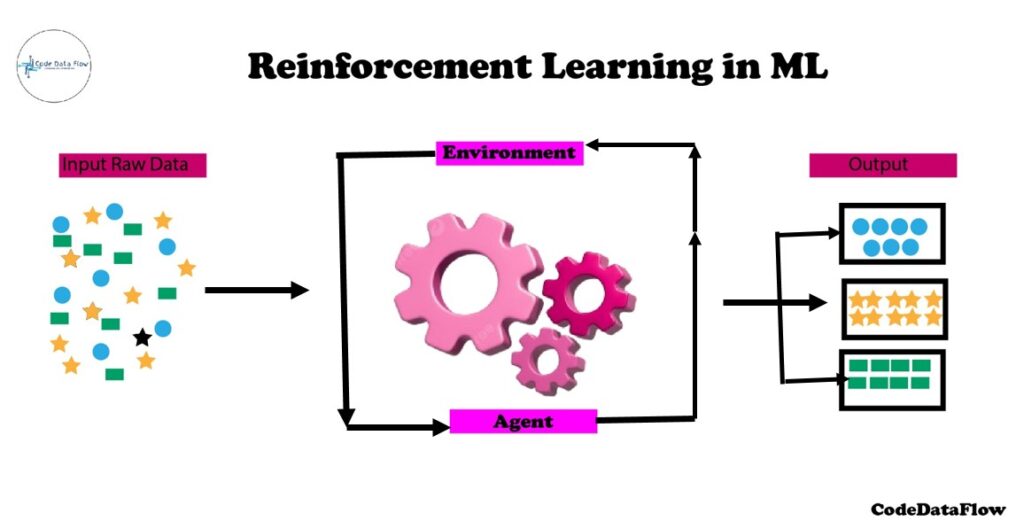
Top 5 Reasons to Learn Reinforcement Learning: A Beginner’s Guide to Smarter AI
Introduction to Reinforcement Learning:
One of the most fascinating areas of artificial intelligence is reinforcement learning, or RL. It imitates how people pick up knowledge from their experiences. In reinforcement learning, machines learn by trial and error, with the goal of maximizing rewards over time, much like a kid learns to walk by trying, failing, and getting back up.
This blog will provide you with an easy-to-understand overview of reinforcement learning, including its definition, methods, uses, and real-world examples. You will leave with clarity and the desire to learn more, regardless of whether you are a student, data enthusiast, or tech blogger.

What is Reinforcement Learning?
A sort of machine learning called reinforcement learning uses actions and feedback in the form of incentives or penalties to teach an agent—a software program or robot—how to behave in a given setting.
Consider it similar to training a dog: you discourage poor behaviour and praise good behaviour with goodies.
The agent’s objective is to gradually increase the overall reward.
Strengthening The core tenet of learning is that an agent—the learner or decision-maker—interacts with the environment in order to accomplish a goal. In order to improve its decision-making over time, the agent takes actions and gets feedback.
- Agent: The one who makes decisions and takes action.
- Environment: The system or world that the agent works in.
- State: The agent’s present circumstances or state.
- Action: The choices or actions that the agent may take.
- Reward: The environment’s reaction to the agent’s behaviour, such as feedback.
How Does Reinforcement Learning Work?
In reinforcement learning (RL), an agent acts in a given environment, is rewarded or punished for those actions, and then modifies its behavior accordingly. In order to optimize the cumulative reward, this loop assists the agent in making better decisions over time.
The components of RL are broken down as follows:
- Policy: A method by which the agent decides what to do next given the situation at hand.
- Reward Function: A function that directs the agent towards its objective by giving feedback on the activities performed.
- Value Function: Calculates the agent’s expected future cumulative rewards from a specific condition.
- Model of the Environment: An environmental representation that helps with planning by forecasting future conditions and rewards.
Key Components of Reinforcement Learning:
| Term | Description |
|---|---|
| Agent | The learner or decision-maker |
| Environment | The world the agent interacts with |
| State (S) | The current situation |
| Action (A) | A decision or move made by the agent |
| Reward (R) | Feedback (positive or negative) |
Real-Life Examples of Reinforcement Learning
1. Game Playing
AI agents like AlphaGo and OpenAI Five use RL to beat human players in games like Go and Dota 2.
2. Self-Driving Cars
Cars learn how to steer, stop, and navigate traffic using sensors and trial-error feedback loops.
3. Industrial Robots
Robots learn to assemble parts or navigate warehouse aisles using reinforcement learning.
Exploration vs Exploitation in RL
A smart agent must balance:
- Exploration: Trying new actions to discover better strategies.
- Exploitation: Using what it already knows to gain rewards.
This balance is crucial for learning efficient and optimized behaviors.
Common Reinforcement Learning Algorithms
| Algorithm | Key Idea |
|---|---|
| Q-Learning | Learn the value of actions in each state |
| SARSA | Similar to Q-Learning but uses on-policy updates |
| DQN | Deep Q-Network that combines neural networks with Q-Learning |
| Policy Gradient | Directly learns policies for action selection |
Types of Reinforcements in RL
1. Positive Reinforcement
When an event that results from a certain behaviour strengthens and increases the frequency of that behavior, this is known as positive reinforcement. To put it another way, it influences behaviour in a favourable way.
Benefits: Enhances performance and aids in maintaining change over time.
Cons: Excessive states brought on by overuse may lessen efficacy.
2. Negative Reinforcement
The strengthening of behaviour as a result of a bad circumstance being avoided or halted is known as negative reinforcement.
Benefits: Ensures a minimal performance level and increases the frequency of behaviour.
Cons: It could only motivate little activity to stay out of trouble.
Why is Reinforcement Learning Important?
Machines that use reinforcement learning are able to:
Adjust to changing conditions
Make choices without labelled information.
Acquire sophisticated behaviours (such as driving or playing games).
It is essential for developing intelligent systems since it replicates human learning.
Applications of Reinforcement Learning in Real Life
Healthcare: Personalized treatment plans
Finance: Portfolio optimization
Marketing: Dynamic pricing models
Energy Systems: Smart grid control
Reinforcement Learning is the future of intelligent systems, not simply a trendy term. RL is influencing a variety of sectors, including gaming and healthcare, because to its capacity to learn from experience, adapt in real time, and continually improve.
Understanding RL is the first step to creating smarter systems, regardless of your level of experience with AI or your interest in machine learning.